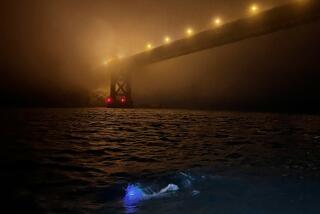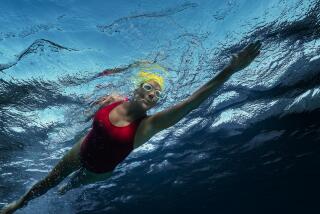Southland Woman, Coach Buoyant After Bering Strait Swim
- Share via
LITTLE DIOMEDE ISLAND, Alaska — Lynne Cox may be one of a kind.
“Nobody else will ever do this,” Joe Coplan said Saturday. “Not in a hundred years. She’s the only one.”
Coplan, 41, is a long-distance swim coach for U.S. Swimming, the national governing body for the sport. The organization neither sanctioned nor sponsored Cox’s Bering Strait swim Friday, but Coplan was the project director.
The 30-year-old Los Alamitos woman swam from this tiny, rocky island to the Soviets’ larger Big Diomede Island on the other side of the International Dateline in 2 hours, 5 minutes.
Swam Five Miles Overall
Although the straight-line distance is only 2.7 statute miles--so close that the two sides watch each other’s movements with telescopes, when the fog lifts--Cox estimated that she swam about five miles overall because of currents.
The water temperature was 44 degrees, about the same as the average glass of ice water, but that was unusually warm for the Bering. It may have been even colder near the end of the ordeal when she was fighting the current within hailing distance of the Soviets, who awaited her with a surprisingly warm reception, literally and figuratively.
Ironically, international public relations almost did her in.
Cox had made several other cold water swims--never that cold for that long, but remarkable for the fact that her basic core body temperature of 97.6 degrees had never dropped.
“This time it dropped,” Coplan said.
After Cox climbed out of the water, her temperature was measured at 94, which is within two degrees of hypothermia, when the body’s normal functions start to shut down. Dr. William Keatinge of the London Medical College calculated that she was into “marginal” hypothermia at the time.
Cox was within 50 yards of the sheer rock cliffs of Big Diomede about an hour and 45 minutes into the swim but altered course south for half a mile, against the current, to where the Soviets had set up a warming tent and buffet tables.
In that last half-mile her temperature dropped dramatically.
“We put her into a slightly hypothermic state by trying to meet the Soviets at the site they set up for us,” Coplan said.
One thing Cox did have going for her were the relatively ideal conditions in an area where the weather and currents change so quickly that the native people hesitate to predict them.
On Friday, the water was smooth and the current only about three-quarters of a knot, whereas, according to the natives, it can run as strong as 10 knots, which would have carried Cox far past Big Diomede toward the Arctic Circle.
Coplan said sunshine might have warmed the surface temperature some, but it was eerily foggy and quiet as Cox nodded her head, then ducked into the water and started to stroke as large flocks of auklets and gulls circled her little flotilla.
“That made it more dramatic,” Coplan said with a shrug.
The fleet of little spectator boats that followed her to the International Dateline left a trail of red and blue balloons that floated in place in her wake, indicating little current.
But even with the conditions, Cox’s talent, her natural fatty insulation and her determination--with all that going for her--the operation was borderline at the end.
“So if she barely made it,” Coplan said, “I don’t see where anybody else would even come close.
“Some people are much faster swimmers than Lynne but don’t have her ability to withstand cold. I know them all. There’s no one else that could have done this.”
Cox wore neither wet suit nor the grease often applied by long-distance swimmers to ward off the cold.
First, that would have rendered the experimental part of the effort useless and, Cox said, “if they had to pull me out of the water, it would be very difficult if I were all covered with grease.”
While the veteran marathon swimmer regarded the swim as the pinnacle of her 16-year career, she had no thoughts about either retiring or planning the next one.
“It’s never it,” she said. “You’re never done. You don’t top it. You just set other goals. It might not necessarily be in swimming.”
More to Read
Go beyond the scoreboard
Get the latest on L.A.'s teams in the daily Sports Report newsletter.
You may occasionally receive promotional content from the Los Angeles Times.






